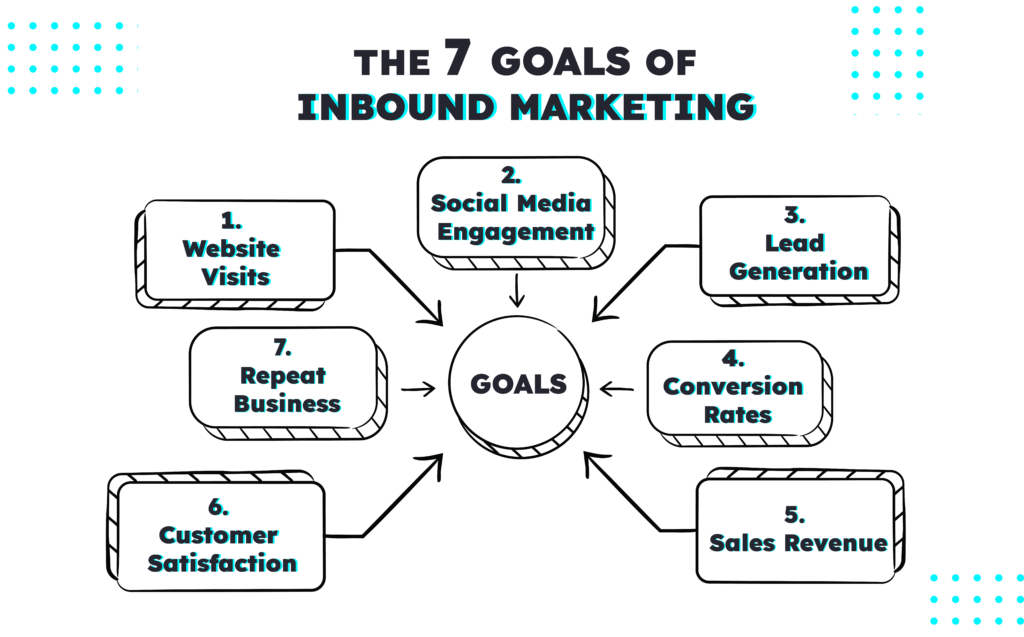
Unlike traditional outbound approaches, inbound marketing revolves around attracting, engaging, and delighting customers through valuable content and personalized experiences. However, navigating the dynamic world of inbound marketing requires more than just creative content creation; it demands a strategic and goal-oriented mindset.
At the heart of this strategic approach lies the concept of goal setting. Inbound marketing is not a haphazard endeavor but a purposeful journey that aligns with the broader objectives of a business. In this blog post, we will delve into the reasons why goal setting is paramount to the success of inbound marketing strategies so you can drive sustainable growth and meaningful connections with your target audience.
Table of Contents
Core Principles of Inbound Marketing

Inbound marketing is built upon a foundation of three core principles, each contributing uniquely to the creation of a comprehensive and effective strategy.
- Attract: Attraction is the initial step in the inbound methodology. It involves capturing the attention of the target audience by creating compelling and relevant content. This content is designed to address the pain points, interests, and needs of potential customers. Through various channels such as blogs, social media, and search engine optimization (SEO), businesses aim to draw individuals into their ecosystem, fostering awareness and curiosity.
- Engage: Once the audience is attracted, the next phase is engagement. Engagement goes beyond mere visibility; it involves building a connection with the audience. This is achieved by providing valuable and informative content that resonates with the audience’s interests. Engagement can take the form of interactive social media conversations, insightful blog comments, or participation in webinars. The goal is to establish a two-way communication channel, encouraging a sense of community and trust between the brand and its audience.
- Delight: The inbound process doesn’t end with a sale; instead, it extends to the post-purchase phase with a focus on delighting customers. Delighting customers involves exceeding their expectations, providing exceptional post-purchase experiences, and creating brand advocates. By consistently delivering value and addressing customer needs even after the sale, businesses can turn customers into promoters who share their positive experiences, thus fueling further attraction and engagement.
The Role of Goals in Inbound Marketing
Before delving into the intricacies of goal setting in inbound marketing, let’s establish a clear understanding of what marketing goals entail. Marketing goals must guide the efforts of a marketing team toward achieving desired outcomes. These objectives can span various aspects of the marketing process, from increasing brand awareness and driving website traffic to generating leads and boosting sales.
Effective inbound marketing begins with aligning marketing goals with broader business objectives. This alignment ensures that marketing efforts are not pursued in isolation but contribute directly to the overall success and growth of the organization. By closely integrating marketing goals with business goals, companies can create a unified and synergistic approach that maximizes impact. For example, if a business aims to expand its customer base, corresponding marketing goals might focus on lead generation and conversion strategies.
The establishment of clear and well-defined marketing goals serves as the compass guiding the development of an inbound marketing strategy. Goals provide the direction and purpose needed to shape every aspect of the marketing plan, from content creation and distribution to engagement tactics and customer retention initiatives. By having specific goals in place, marketing teams can tailor their strategies to address identified needs and opportunities. For instance, if the goal is to increase website traffic, the strategy might involve SEO optimization, content marketing, and social media campaigns.
Furthermore, goals act as key performance indicators (KPIs) that enable teams to measure and evaluate the success of their efforts. Regularly tracking progress against these goals allows for data-driven decision-making, helping marketing teams refine and optimize their strategies for maximum impact. Whether the goal is to enhance brand visibility, nurture leads through the sales funnel, or improve customer satisfaction, each goal shapes the tactical and strategic decisions that drive the overarching inbound marketing strategy.
The SMART Criteria for Inbound Marketing Goal Setting
Specific
When setting goals in the realm of inbound marketing, specificity is paramount. A specific goal leaves no room for ambiguity, clearly defining what needs to be achieved. Rather than a vague aim like “increase website traffic,” a specific goal might be “increase organic website traffic by 20% in the next quarter.” This precision provides a clear direction for efforts and facilitates focused action.
Measurable
Measuring progress is a cornerstone of effective goal setting. Goals should be quantifiable, allowing for the tracking of achievements and providing a basis for evaluating success. For instance, instead of a broad goal like “improve social media engagement,” a measurable goal could be “increase average monthly social media engagement by 15%.” This way, teams can assess their performance against concrete metrics, facilitating data-driven decision-making.
While setting ambitious goals is admirable, they must remain within the realm of achievability. Goals should inspire effort and dedication without being so unrealistic that they demotivate. An achievable goal takes into account the available resources, skills, and time. For instance, instead of aiming to “double website traffic overnight,” a more achievable goal might be to “increase website traffic by 30% over the next six months.”
Relevant
Every goal set in the context of inbound marketing should be directly aligned with broader business objectives. A relevant goal ensures that efforts contribute meaningfully to the overall success of the organization. For example, a goal to “optimize blog content for SEO” is relevant if the business objective is to increase online visibility and organic search traffic.
Time-Bound
Timeframes add a crucial dimension to goal setting, providing a sense of urgency and helping teams prioritize tasks. A time-bound goal has a specified deadline, creating a sense of accountability and focus. Instead of a goal like “improve email campaign performance,” a time-bound goal could be “achieve a 20% increase in email click-through rates within the next two months.” This timeframe establishes a clear endpoint for assessment and encourages timely action.
Types of Goals in Inbound Marketing

Understanding and strategically setting goals within these categories not only provides clarity to the inbound marketing strategy but also enables businesses to focus their efforts on areas crucial for growth, engagement, and long-term success.
Each type of goal contributes to the overall effectiveness of the inbound marketing funnel, creating a holistic approach to customer acquisition and retention:
1. Website Visits
One of the fundamental goals in inbound marketing is to increase website traffic. This involves attracting a larger audience to explore the company’s online presence. Metrics such as unique visitors, page views, and session duration are critical indicators of the effectiveness of efforts to draw visitors to the website.
2. Social Media Engagement
In the age of social connectivity, fostering engagement on platforms like Facebook, Twitter, and Instagram is integral to inbound marketing. Goals in social media engagement may include increasing followers, encouraging likes and shares, and creating a community around the brand.
3. Lead Generation
Businesses employ a variety of strategies to generate leads, recognizing that the acquisition of potential customers is a multifaceted process crucial for sustained growth and success. Common goals are:
- Content Downloads: Generating leads involves capturing valuable information from potential customers. Content downloads, such as ebooks, whitepapers, or guides, serve as magnets to attract individuals interested in the brand’s offerings. The number of downloads becomes a tangible metric for assessing lead generation success.
- Newsletter Subscriptions: Building a subscriber base for newsletters is a key goal for cultivating leads. This not only allows for direct communication with potential customers but also provides an avenue for delivering targeted content. Increasing the number of newsletter subscriptions is a measurable goal indicating a growing pool of interested prospects.
- Webinar registrations: Hosting webinars is an effective lead generation strategy, offering an interactive platform to showcase expertise and engage with the audience. Setting goals for webinar registrations helps in assessing the interest level of the target audience and provides an opportunity for in-depth interaction.
- Free Trial Sign-ups: For businesses offering products or services with a trial period, encouraging free trial sign-ups is a goal that directly contributes to lead generation. It allows potential customers to experience the value firsthand, making them more likely to convert into paying customers.
- Demo Requests: For businesses offering complex products or services, goal setting for demo requests is crucial. It indicates an interest in a more in-depth exploration of what the brand has to offer, making it a significant step in the lead nurturing process.
4. Conversion Rates
Converting leads into customers is a pivotal goal in the inbound marketing journey. Conversion rates measure the percentage of leads that successfully transition into customers. By setting goals to improve conversion rates, businesses can refine their sales funnel and enhance the efficiency of the customer acquisition process.
5. Sales Revenue
Ultimately, the overarching goal of inbound marketing is to contribute to the revenue generation of the business. Setting specific revenue targets aligns marketing efforts with the financial objectives of the organization. This may involve tracking the revenue generated from specific campaigns or channels to evaluate their effectiveness.
6. Customer Satisfaction
Beyond the initial sale, maintaining high levels of customer satisfaction is a critical goal for inbound marketing. Measuring customer satisfaction through surveys, feedback forms, or reviews helps in understanding the effectiveness of post-purchase interactions and overall customer experience.
7. Repeat Business
Encouraging repeat business from existing customers is a valuable goal for sustained growth. This involves creating strategies to nurture customer loyalty, such as loyalty programs, personalized offers, and ongoing communication. The number of repeat purchases serves as a metric for the success of these retention efforts.
Challenges in Goal Setting for Inbound Marketing

1. Overambitious Goals
Overly ambitious goals present a common challenge in the realm of inbound marketing. While ambition is undoubtedly commendable, the risk of setting objectives beyond practical feasibility can be mitigated through strategic solutions. Enter Pathmonk Accelerate, an AI-powered lead generation software designed to seamlessly enhance your inbound marketing results.
Implementing Pathmonk Accelerate offers a streamlined approach to goal achievement, leveraging artificial intelligence to create personalized micro experiences for your website users. This personalized approach is tailored in real-time based on the user’s intent, resulting in a significant conversion boost – an average improvement of over 50%.
By incorporating Pathmonk Accelerate into your inbound marketing strategy, you optimize lead generation and mitigate the pitfalls associated with overly ambitious goals. The software’s ability to dynamically adapt and respond to user behavior ensures a realistic and motivating pursuit of excellence. This innovative solution minimizes resource strain, enhances the quality of execution, and alleviates undue pressure on marketing teams.
Increase +180%
leads
demos
sales
bookings
from your website with AI
Get more conversions from your existing website traffic delivering personalized experiences.

2. Lack of Alignment with Business Goals
A critical challenge in goal setting for inbound marketing arises when there is a misalignment between marketing goals and broader business objectives. For marketing efforts to contribute meaningfully to the overall success of the organization, there must be a clear and cohesive connection between the two. Without this alignment, marketing initiatives risk becoming detached from the strategic vision of the business, leading to inefficiencies and missed opportunities. It’s imperative to regularly reassess and realign marketing goals with the evolving needs and objectives of the business.
3. Inadequate Measurement Tools
The effectiveness of goal setting hinges on the ability to measure progress accurately. Inadequate measurement tools and analytics can impede the evaluation of key performance indicators (KPIs) and hinder the understanding of what works and what doesn’t. Without reliable data, marketing teams may struggle to make informed decisions, optimize strategies, and demonstrate the impact of their efforts.
Investing in robust analytics tools, -such as Quantive, Asana, or Perdoo– and regularly refining measurement processes is essential to overcoming this challenge and ensuring the precision needed for effective goal assessment.
Conclusion
Goal setting in inbound marketing is not merely a strategic exercise but a compass that guides businesses toward sustainable growth and meaningful customer connections. By adhering to the SMART criteria, businesses can ensure their goals are specific, measurable, achievable, relevant, and time-bound, setting the stage for effective planning and execution. However, recognizing and overcoming challenges is equally crucial.
In this dynamic landscape, tools like Pathmonk Accelerate provide a cutting-edge solution, enhancing lead generation with AI-powered personalized microexperiences. The convergence of goal-setting best practices and innovative technologies enables marketing teams to navigate challenges, strike the right balance, and ultimately drive success in the ever-evolving world of inbound marketing.





